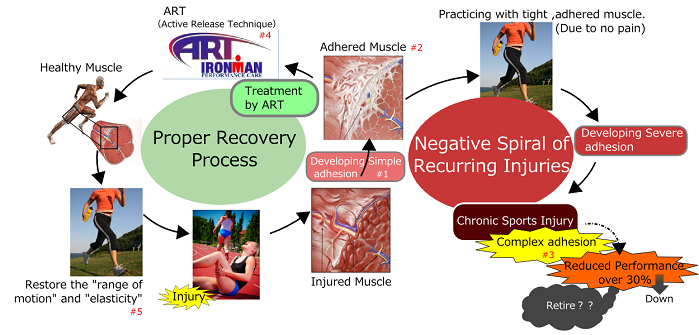
TOP / ABOUT US / Soft Tissue Injury Cycle

Soft Tissue Injury Cycle

#1 ) Developing Sinmple Adhesion (micro fiber formation)
In order to cure the micro soft tissue trauma, our body start gathering blood, protein, collagen to repair the traumatized location. This is called Scarring process. (Imagine: when you cut the fingers it happens same cycle)
#2 ) Adhered Muscle
It starts forming extra micro fibers in particular location. In this phase, often time muscle performance will reduced in 1 particular motion. ( For example:Tennis elbow, Golf elbow, Achilles tendonitis, Hamstring pain).
This microfibers do not have Elasticity or Strength like healthy muscle or soft tissues. Thus Forming Scar Tissue weakens your performance in cellular level.
#3 ) Complex Adhesion (Multiplied Adhesions)
When the simple adhesion left for enough time, the adhesion scar tissue demonstrates hypoxia (less oxygen due to less blood supply) in your injury location. Then the healing process will be disturbed significantly this is called “Chronic Injury” (For Example Chronic Low Back Pain, Tight neck, Frozen Shoulder) and even more worse, there will be nerve involvement in some case. (Sciatic pain, numbness in hands, Carpal tunnel Syndrome. In this phase people can not perform their usual performance such as run, swim, bike, swing, punch, kick, throw, jump and so on.
#4 ) 90% of muscle or joint pain without X-ray or MRI evidence came from adhesion scar tissue. Active Release Technique has been helping with these conditions with scientific evidence since 2002. (The year of medical patent has proven at San Diego Medical Center.)
#5 ) Restore the "range of motion" and "elasticity"
The full function of your muscle can be occure only when you restore the full range of motion of all soft tissues. ( muscle, tendon, joint capsule and ligament)
When your muscle has less adhesion scarrtissue muscle function will be increase so as your performance. (Due to increase elasticity of your muscle increase the function of "Muscle spindle" and "Golgi tendon".
In order to cure the micro soft tissue trauma, our body start gathering blood, protein, collagen to repair the traumatized location. This is called Scarring process. (Imagine: when you cut the fingers it happens same cycle)
#2 ) Adhered Muscle
It starts forming extra micro fibers in particular location. In this phase, often time muscle performance will reduced in 1 particular motion. ( For example:Tennis elbow, Golf elbow, Achilles tendonitis, Hamstring pain).
This microfibers do not have Elasticity or Strength like healthy muscle or soft tissues. Thus Forming Scar Tissue weakens your performance in cellular level.
#3 ) Complex Adhesion (Multiplied Adhesions)
When the simple adhesion left for enough time, the adhesion scar tissue demonstrates hypoxia (less oxygen due to less blood supply) in your injury location. Then the healing process will be disturbed significantly this is called “Chronic Injury” (For Example Chronic Low Back Pain, Tight neck, Frozen Shoulder) and even more worse, there will be nerve involvement in some case. (Sciatic pain, numbness in hands, Carpal tunnel Syndrome. In this phase people can not perform their usual performance such as run, swim, bike, swing, punch, kick, throw, jump and so on.
#4 ) 90% of muscle or joint pain without X-ray or MRI evidence came from adhesion scar tissue. Active Release Technique has been helping with these conditions with scientific evidence since 2002. (The year of medical patent has proven at San Diego Medical Center.)
#5 ) Restore the "range of motion" and "elasticity"
The full function of your muscle can be occure only when you restore the full range of motion of all soft tissues. ( muscle, tendon, joint capsule and ligament)
When your muscle has less adhesion scarrtissue muscle function will be increase so as your performance. (Due to increase elasticity of your muscle increase the function of "Muscle spindle" and "Golgi tendon".





